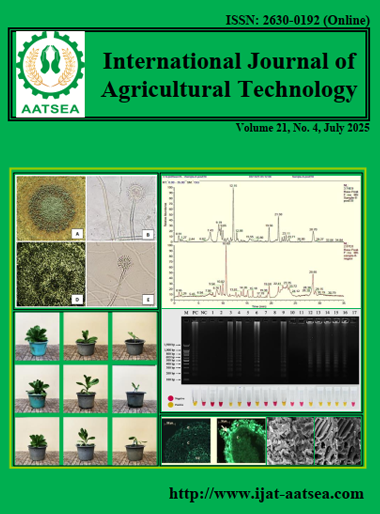The effects of rate and timing of cricket frass application on Kalmegh (Andrographis paniculata) production in low-fertility soils
Main Article Content
Abstract
The findings indicated that the varying rates of cricket frass application affected parameters such as shoot height, shoot fresh weight, and shoot dry weight. The treatment that applied cricket frass at 48 kg ha-1 yielded the highest values for shoot height (49.52 cm), shoot fresh weight (31.89 g plant-1), and shoot dry weight (8.69 g plant-1). Considering the various periods for applying cricket frass before planting, the results showed that the timings significantly impacted only the shoot fresh weight. Applying cricket frass 0 day before transplanting (applying on the same day as transplanting) resulted in the highest shoot fresh weight (23.40 g plant-1). Additionally, interactions between the rate of cricket frass application and the timing of cricket frass application before planting were observed in relation to shoot height, shoot fresh weight, and shoot dry weight of kalmegh. Specifically, applying cricket frass at a rate of 48 kg ha-1 on the same day as transplanting led to the highest shoot fresh weight (34.46 g plant-1) and shoot dry weight (9.55 g plant-1). Therefore, cricket frass showed potential as a fertilizer for enhancing the yield of kalmegh (Andrographis paniculata) in low-fertility soils.
Article Details

This work is licensed under a Creative Commons Attribution-NonCommercial-NoDerivatives 4.0 International License.
References
Andrianorosoa Ony, C., Solofondranohatra, C. L., Ramiadantsoa, T., Ravelomanana, A., Ramanampamonjy R, N., Hugel, S. and Fisher, B. L. (2024). Effect of Cricket Frass Fertilizer on growth and pod production of green beans (Phaseolus vulgaris L.). Plos One, 19:e0303080.
Azeez, J. O. and Van Averbeke, W. (2010). Fate of manure phosphorus in a weathered sandy clay loam soil amended with three animal manures. Bioresource Technology, 101:6584-6588.
Basak, B. B., Jat, R. S., Gajbhiye, N. A., Saha, A. and Manivel, P. (2020). Organic nutrient management through manures, microbes and biodynamic preparation improves yield and quality of Kalmegh (Andrograghis paniculata), and soil properties. Journal of Plant Nutrition, 43:548-562.
Brady, N. C. and Weil, R. R. (1996). The nature and properties of soils. https://www.cabidigitallibrary.org/doi/full/10.5555/19961906536
Butnan, S. and Duangpukdee, J. (2021). Cricket frass: The high-quality organic fertilizer for vegetable growth improvement. Khon Khen Agriculture, 49(Suppl.):883-887.
Castañeda, V. and González, E. M. (2021). Strategies to apply water-deficit stress: Similarities and disparities at the whole plant metabolism level in Medicago truncatula. International Journal of Molecular Sciences, 22:2813.
Chouhan, S., Meena, K. C., Soni, N., Patidar, D. K., Kachouli, B. K. and Haldar, B. P. A. (2023). Response of recommended dose of fertilizers with organic manures on growth, yield and economics of kalmegh (Andrographis paniculata Nees.): A way to reduced use of chemical Fertilizers. The Pharma Innovation Journal, 12:119-124.
Department of Agriculture (2012). The criteria for organic fertilizer according to the notification of Department of Agriculture B.E.2555. Retrieved from https://www.doa.go.th/ard/wp-content/uploads/2019/11/FEDOA5.pdf. (Thai).
Detpiratmongkol, S., Ubolkerd, T. and Yoosukyingstaporn, S. (2014). Effects of chicken, pig and cow manures on growth and yield of Kalmegh (Andrographis paniculata Nees). Journal of Agricultural Technology, 10:475-482.
Halloran, A., Hanboonsong, Y., Roos, N. and Bruun, S. (2017). Life cycle assessment of cricket farming in north-eastern Thailand. Journal of Cleaner Production, 156:83-94.
Kagata, H. and Ohgushi, T. (2012). Positive and negative impacts of insect frass quality on soil nitrogen availability and plant growth. Population Ecology, 54:75-82.
Khushboo Khan, K. K., Umesh Pankaj, U. P., Verma, S. K., Gupta, A. K., Singh, R. P. and Verma, R. K. (2015). Bio-inoculants and vermicompost influence on yield, quality of Andrographis paniculata, and soil properties. Industrial Crops and Products, 70:404-409.
Ogaji, S. O., Watako, A. O., Nyongesah, J. M. and Peter, B. (2022). Effects of cricket frass biofertilizer on growth of spring onion (Allium fistulosum L.) and physicochemical properties of soil. Journal of Modern Agriculture and Biotechnology, 1:14.
Sriraj, P., Toomsan, B. and Butnan, S. (2022). Effects of Neem Seed Extract on Nitrate and Oxalate Contents in Amaranth Fertilized with Mineral Fertilizer and Cricket Frass. Horticulturae, 8:898.
Wanjugu, A., Bulli, P. and Andika, D. (2023). Effects of cricket frass on vegetative growth of Cleome gynandra. African Journal of Agricultural Research, 19:210-215.
Wantulla, M., Dicke, M. and Van Loon, J. J. A. (2023). Effects of amending soil with black soldier fly frass on survival and growth of the cabbage root fly (Delia radicum) depend on soil type. Journal of Pest Science. Journal of Pest Science, 202397:1-9.
Zhao, M., Zhao, J., Yuan, J., Hale, L., Wen, T., Huang, Q., Vivanco, J. M., Zhou, J., Kowalchuk, G. A. and Shen, Q. (2021). Root exudates drive soil‐microbe‐nutrient feedbacks in response to plant growth. Plant, Cell & Environment, 44:613-628.


